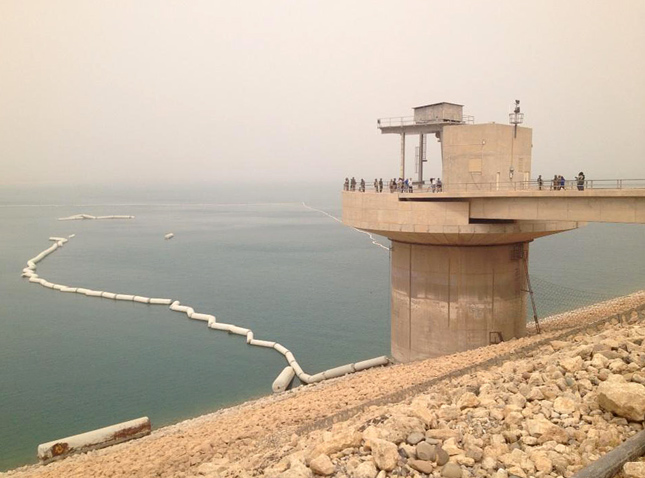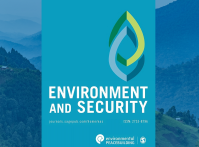-
What Can Iraq’s Fight Over the Mosul Dam Tell Us About Water Security?
The fight for control over “the most dangerous dam in the world” is raging.
Since its capture by Islamic State (IS) militants on August 7 and subsequent attempts by Iraqi government and Kurdish forces to take it back, Iraq’s Mosul Dam has been one of the central components of the government’s surprising and rapid collapse in the country’s northern and western provinces. In fact, one might see the capture of the Mosul Dam as the moment IS ascended from a dangerous insurgent group to an existential threat to Iraq as a state.
Water factors into conflict in ways that defy easy classification
Is the fight for Mosul Dam a “water war?” Has the scarcity-induced chaos that many have predicted finally arrived? Not exactly.
The dynamics of the conflict and water’s role in it are multifaceted. It cannot be characterized as a simple fight over dwindling water resources. However, the military struggle between IS, the Iraqi government, and Iraqi Kurdish fighters does vividly demonstrate the numerous ways water intersects with violent conflict. From the plainly illustrated strategic value of dams, to its use as a weapon of war, a spoil, driver, and potential peacebuilding tool, water factors into conflict in ways that defy easy classification.
Critical, But Vulnerable, Infrastructure
The Mosul Dam is located on the Tigris River in a valley about 30 miles north of the city of Mosul, Iraq’s second largest and home to 1.8 million people. In operation since 1986, the dam generates upwards of 310 MW of electricity a day; holds back over 11 billion cubic meters of water; and is used for flood control, municipal water supplies, and irrigation, a crucial lifeline for thousands of farmers in Iraq’s northern Ninevah province.
A 15-foot high wave would carry on to Baghdad, over 270 miles away
Despite its significance to national infrastructure and the wellbeing of millions, concerns over poor security have been voiced for years. The dam was constructed on highly soluble soil, meaning it requires constant repairs. During the 2003 invasion, U.S. forces identified the protection of the dam as a primary objective, and, in 2006, it was described by the U.S. Army Corps of Engineers as “the most dangerous dam in the world.”
Between 2006 and 2010, $30 million was poured into upgrades, but the dam remains critically vulnerable thanks to its perpetual structural problems and the tenuous security environment surrounding it.
In early August, as the fall of the dam became increasingly evident, many news stories and analyses emphasized the incredible destructive potential then controlled by the Islamic State. Some of these reports relied on data from a 2009 article by two Iraqi academics that simulated the effects of a Mosul Dam break. Their findings make for terrifying reading: In the case of a severe dam failure, Mosul would be buried beneath an 80-foot wave crashing down at a velocity of over 3.5 meters a second, and the resulting flood would be so strong that a 15-foot high wave would carry on to Baghdad, over 270 miles away.
The Tipping Point
Judging by reports of extreme brutality, as well as their genocidal rhetoric, there is ample reason to fear the Islamic State’s control of Iraq’s largest dam. The U.S. government and its allies evidently agree. It was a confluence of factors, including the violent persecution of the Yazidi religious minority, the continued advance on the Kurdish capital of Irbil, and the fall of the dam, which likely tipped the balance and prompted the start of U.S. airstrikes on August 8.
Initial targets seem to have been militant positions around Mount Sinjar to help establish a safe corridor for many of the trapped Yazidi. But soon the U.S. turned its attention to dislodging IS fighters from around the dam, which was explicitly cited by the White House on August 17 in its justification for more air strikes:
The failure of the Mosul dam could threaten the lives of large numbers of civilians, endanger U.S. personnel and facilities, including the U.S. Embassy in Baghdad, and prevent the Iraqi government from providing critical services to the Iraqi populace.
According to the latest reports, it appears these strikes have made a difference as Iraqi Kurdish forces have regained control of the dam, hopefully easing fears of IS using it as a catastrophic weapon against the Iraqi populace.
Water as a Weapon
The battle over control of the Mosul Dam provides a dramatic centerpiece that has captured the public imagination, but it is not the first time water has played an important role in this war.
In April, reports emerged of attempts by IS to manufacture a drought by closing the floodgates of the small Nuaimiyah Dam on the Euphrates River near Islamic State-controlled Fallujah. The resulting water crisis affected millions of people in the predominantly Shia cities of Karbala and Najaf and was partly responsible for two-thirds of the polling stations in Anbar province being closed during recent parliamentary elections.
The Middle East is in the midst of its worst drought in at least 60 years
There are conflicting reports about what happened next – IS claims the Iraqi government decided to open the floodgates further upstream, thereby flooding Fallujah and surrounding regions, while the Iraqi government says IS caused the flooding themselves by mismanaging the Nuaimiyah Dam. Regardless, water levels in the area rose significantly and overflowed the Euphrates banks into irrigation canals. Some 60,000 people lost their homes, schools were destroyed, and almost 50,000 acres of agricultural land were flooded.
Water has sparked regional tensions as well. In May, there were accusations that Turkey (or Syria, or IS, depending on the source) reduced the flow of the Euphrates into certain parts of Syria and Iraq, with millions of people being left without adequate drinking water as a result.
And hanging above it all is the fact that the Middle East is in the midst of its worst drought in at least 60 years.
Beyond Water Wars
The crisis in Iraq demonstrates how water can play a number of pivotal roles in conflict and peace, without being the primary causal factor – and why that distinction is important.
Traditionally understood, a “water war” reflects a zero-sum game arising from scarcity. This approach emphasizes Malthusian concerns of growing populations, which lead to high resource consumption, water degradation and scarcity, furthering competition between states and finally leading to the outbreak of violence and war. This calculus reflects a rather simplistic reduction of the variety of reasons why conflict breaks out, as well as the different ways water factors into conflict other than as a lootable resource.
Aaron Wolf on transboundary water basins and risk The Islamic State appears to be primarily interested in using water as a strategic leverage point or component in its project to establish a long-lasting Caliphate rather than as a tactical weapon. According to one report, once they took control of the Mosul Dam, IS officials told workers their salaries would be paid, provided the dam remained in operation and electricity was generated for the region under its control. This would seem to adhere to other reports that detail how IS uses its control of oil fields, oil revenues, and petroleum products primarily as income generating projects.
The distinction is important because it can frame how we anticipate and respond to water problems. Labeling a conflict a “water war” reduces the complexity of water to a single conflict variable. But water intersects with society in all its forms and is also important for peacebuilding and establishing government legitimacy.
Water provision is a crucial component of the state. The failure to provide adequate water supplies reflects a failure to provide basic security and justice, core functions of the state. In this regard, improvements to water infrastructure and management should be seen as key peacebuilding interventions in places like Iraq.
Conflict Is Never Simple
This is a dangerous trend which leaves violent conflict as a product of geography rather than human decisions
It is clear water has ascended as a key security variable for the Islamic State, for Iraq, and for the wider international community. And it’s understandable that in the rush to portray the existential threat posed by the Islamic State controlling vast water resources, officials and journalists have focused on the struggle over scarce resources and the potential for catastrophic damage. A careful reading of the situation, however, reveals multiple layers of complexity and interaction between water and security that suggest more calculated motives.
In Iraq, water is being used as a weapon, for covert diplomacy, blackmail, economic development, and as a discourse justifying armed intervention – but none of these things make the conflict a water war.
Labeling it as such overlooks more complex dynamics and reduces causality to a single variable. This is a dangerous trend which leaves violent conflict as a product of geography rather than human decisions and obscures important interventions that can build lasting peace.
Cameron Harrington is the 2014 NRF Global Change Postdoctoral Fellow in the Global Risk Governance Program at the University of Cape Town, where he researches conflict and cooperation along vulnerable river catchments. He received his PhD in Political Science from Western University in London, Canada.
Schuyler Null is the editor of New Security Beat and a writer/editor with the Wilson Center’s Environmental Change and Security Program.
Sources: Al-Taiee and Rasheed (2009), The Atlantic, BBC News, Bloomberg, Foreign Policy, The Independent, International Water Power and Dam Construction, Keith Johnson, The New York Times, Organization for Economic Cooperation and Development, Pacific Institute, Qantara, Reuters, RT, U.S. Army Corps of Engineers, The Wall Street Journal, The Washington Post.
Photo Credit: The Mosul Dam after Peshmerga cleared the way on August 19, used with permission courtesy of Wall Street Journal Reporter Nour Malas. Video: Sean Peoples/Wilson Center.
 A Publication of the Stimson Center.
A Publication of the Stimson Center.







